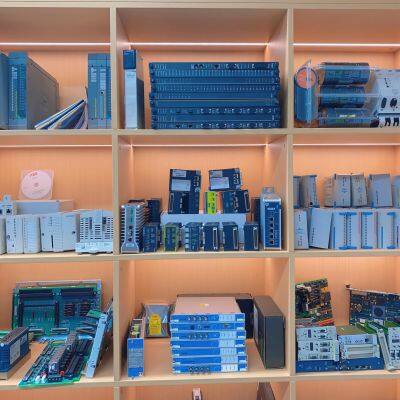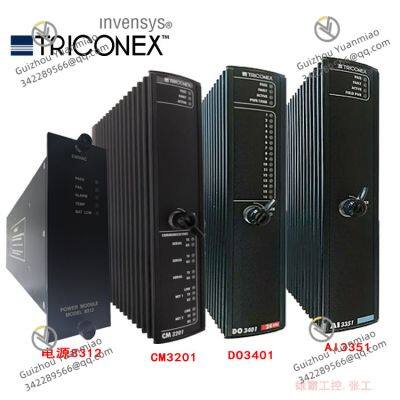Product Description
TRICONEX Series Module -2
I. Overview
The TRICONEX AO3482 is an analog output module. As a core I/O component of the TRICONEX Triple Modular Redundancy (TMR) control system, its primary function is to convert continuous control commands issued by the control system (such as valve opening adjustment, motor speed control, temperature and pressure setpoints, etc.) into standard analog signals (4-20mA or 0-10V) executable in industrial on-site environments. It enables precise and continuous control of actuators and serves as a crucial bridge connecting the control layer and on-site regulating equipment.
The AO3482 plays an especially critical role in fields with extremely high requirements for process precision and system safety, such as petrochemicals, fine chemicals, and energy power generation. For example, in the cracking furnace control system of a large ethylene plant, the Advanced Process Control (APC) system needs to issue continuous opening commands to fuel gas control valves and feed rate control valves. The AO3482 can stably output 4-20mA analog signals in harsh environments with high temperatures and high corrosive gases, ensuring that the valve opening accurately follows command changes and avoiding abnormal cracking depth caused by signal fluctuations. In the steam generator water level control system of a nuclear power plant, this module can output 0-10V adjustment signals to feedwater control valves. Its redundant design and high-precision output characteristics can effectively address the risk of signal drift under extreme operating conditions, ensuring the stable operation of nuclear island equipment.
II. Core Features
(1) High-Precision Output and Wide Range Adaptation
The AO3482 is equipped with 8 independent analog output channels. A single module can meet the centralized control needs of multiple regulating actuators, significantly reducing the number of modules in the control cabinet and the complexity of wiring. This module supports two types of standard analog signals: 4-20mA current output and 0-10V voltage output, with an output accuracy of up to ±0.1% F.S. (Full Scale), enabling flexible adaptation to different types of on-site regulating equipment. For instance, for intelligent control valves driven by 4-20mA (such as Fisher control valves) or variable frequency drives (VFDs) driven by 0-10V (such as Siemens VFDs), there is no need to configure additional signal conversion modules. Signal type switching can be achieved directly through software configuration, and it also supports custom range calibration (e.g., mapping 4-20mA to 0-100% valve opening) to meet the control requirements of different process scenarios.
In Chemical Vapor Deposition (CVD) equipment for semiconductor wafer manufacturing, the control signals for 6 regulating devices (including reaction chamber pressure control valves and gas flow controllers) can be centrally output by a single AO3482 module. Its accuracy of ±0.1% F.S. ensures that the gas flow control error is ≤0.5%, meeting the strict requirements of the wafer deposition process.
(2) Triple Modular Redundancy Design Ensures Safety and Reliability
As a supporting module for the TRICONEX TMR system, the AO3482 adopts a triple modular redundancy design for signal generation and output, consistent with the system architecture. Each output signal undergoes triple modular processing through independent D/A conversion circuits, signal amplification circuits, and isolation circuits. The redundant logic inside the module performs consistency verification and deviation judgment on the three sets of output signals. If a single channel experiences signal drift or failure, the system can automatically shield the abnormal channel and drive the output based on the average value of the other two normal signals, ensuring continuous and stable signal output with deviations controlled within ±0.2% F.S.
In the pressure regulation station of a natural gas long-distance pipeline, the outlet pressure control valve needs to receive a 4-20mA continuous adjustment signal. The AO3482 ensures reliable signal transmission through triple modular output. Even if a single D/A conversion circuit has a drift of 0.5% F.S., the redundant logic can correct the output using the other two normal signals, avoiding the risk of pipeline pressure overrun caused by abnormal valve opening.
(3) Enhanced Anti-Interference and Electrical Isolation
Targeting the complex electromagnetic environment of industrial sites, the AO3482 adopts a channel-level photoelectric isolation (isolation voltage ≥ 2500Vrms) and all-metal shielded housing design. Each output channel is completely isolated from the module's internal circuit, which can effectively suppress ground loop interference and common-mode interference (with a rejection ratio ≥ 80dB). The shielding effectiveness of the metal housing is ≥ 40dB, which can resist radiated interference generated by industrial equipment (such as high-voltage VFDs and high-power motors). This ensures that the output signal drift is ≤ 0.05% F.S./h in strong electromagnetic environments like steel plants and non-ferrous metal smelters, which is much lower than the 0.1% F.S./h drift threshold of traditional analog output modules.
For example, in the thickness control system of a continuous rolling mill in a large steel plant, the high-voltage VFD of the mill drive motor generates strong electromagnetic radiation. However, the 4-20mA signal output by the AO3482 to the roll pressing control valve has a drift of only 0.03% F.S. during 24-hour continuous operation, ensuring that the strip thickness control accuracy is maintained within ±0.02mm.
(4) Real-Time Diagnosis and Fault Early Warning
The module integrates a full-channel online diagnosis function, which can real-time monitor the signal status of each output channel (such as open circuit, short circuit, overload, and signal drift) and transmit the diagnosis results to the controller and upper computer via the TRICONEX system bus. When an open-circuit fault occurs in a channel (e.g., broken signal wire), the module can trigger a fault alarm within 10ms and automatically switch the output signal to a preset safe value (e.g., 4mA corresponding to full valve closure). If signal drift exceeding ±0.3% F.S. is detected, the drift data is reported in real-time to remind operation and maintenance personnel to perform calibration. Operation and maintenance personnel can directly view the fault channel number, fault type, and drift amount through the upper computer, reducing the Mean Time To Repair (MTTR) to less than 15 minutes.
In the bioreactor control system of the pharmaceutical industry, if a short circuit occurs in the channel for the stirring speed adjustment signal output by the AO3482, the module can immediately trigger an alarm and switch the output to 4mA (corresponding to the minimum speed), avoiding fermentation failure caused by uneven mixing of materials in the reactor.

III. Technical Specifications
(1) Electrical Parameters
(2) Mechanical and Environmental Parameters
Overall Dimensions: 160mm×120mm×80mm (Length×Width×Height), compatible with TRICONEX standard racks, installed with 2U height
Weight: Approximately 0.95kg, lightweight design facilitates module insertion/extraction and cabinet layout
Operating Temperature Range: -40℃~+70℃, meeting the usage requirements of extremely cold areas (such as Northeast Oilfields) and high-temperature workshops (such as glass kilns)
Storage Temperature Range: -40℃~+85℃, adapting to long-distance transportation and storage environments
Protection Level: IP20 (front panel), suitable for installation in industrial control cabinets
Vibration Resistance: 5g acceleration (10Hz~2000Hz), complying with IEC 60068-2-6 standard
(3) Performance Parameters
Signal Response Time: ≤500μs (from command reception to stable output, deviation ≤0.1% F.S.)
Signal Drift: ≤0.05% F.S./h (at 25℃), ≤0.1% F.S./h (-40℃~+70℃)
Diagnostic Coverage: ≥99.9% (channel-level fault diagnosis, including signal drift, open circuit, short circuit)
MTBF (Mean Time Between Failures): ≥1,200,000 hours (complying with MIL-HDBK-217 standard, at 25℃)
Communication Interface: Compatible with TRICONEX TMR system bus, data transmission rate ≥100Mbps
IV. Functions and Working Principles
(1) Analog Signal Output Process
Command Reception and Parsing: Analog control commands issued by the control system (e.g., "50% valve opening" corresponding to 12mA current) are transmitted to the AO3482 via the TRICONEX system bus. The command parsing unit inside the module decodes the commands and confirms the output channel, signal type (4-20mA/0-10V), and target value corresponding to the commands.
Triple Modular D/A Conversion: The parsed commands are synchronously transmitted to three independent D/A conversion units inside the module. Each unit converts the digital signal into a corresponding analog signal (e.g., 12mA current or 5V voltage) based on the commands, and performs consistency verification on the three sets of signals via the internal redundant bus (allowable deviation range: ±0.05% F.S.).
Signal Amplification and Isolation: The analog signals that pass the verification enter the channel-level amplification circuit, where they are amplified to the standard output range (e.g., 4-20mA) via a high-precision operational amplifier. They then pass through a photoelectric isolation circuit to be isolated from the module's internal power supply, preventing interference from on-site loads from entering the module's core circuit.
Output and Status Monitoring: The isolated analog signals are transmitted to on-site regulating equipment through output terminals. At the same time, the module's status monitoring unit real-time collects the current/voltage values and load impedance of the output signals. If an open circuit, short circuit, or signal drift exceeding the threshold is detected, it immediately triggers a protection mechanism (e.g., switching to a safe value) and reports the fault information.
(2) Cooperative Working Mechanism with TMR System
As the I/O execution end of the TRICONEX TMR control system, the AO3482 realizes data interaction with the system's triple modular controllers (such as TRICON 5730) via a dedicated redundant bus:
Command Synchronization: The controller synchronously issues digital commands to the three D/A conversion units every 200μs. The three units independently complete digital-to-analog conversion, ensuring no delay or loss in command transmission, with an output signal update frequency ≥5kHz.
Fault Tolerance: If a single D/A conversion unit of the AO3482 fails (e.g., accuracy drift exceeding ±0.3% F.S.), the controller can automatically ignore the output of this unit through the diagnostic information uploaded by the module and drive the output based on the average value of the other two units, ensuring the total output deviation ≤±0.2% F.S.
Online Calibration and Maintenance: Without shutting down the TMR system, the AO3482 can be calibrated online (by sending calibration commands via the upper computer) or replaced via hot swapping. The system automatically identifies the new module and loads preset parameters. During calibration, the output signal deviation is ≤±0.1% F.S., meeting the "non-stop maintenance" requirement of industrial production.
ABB GRID BREAKER UNIT GBU72 3BHB030310R0001
TRICONEX CM2201 7400206-100 Communication Module Baseplate
TRICONEX DI2301 7400208-020 Digital Input Baseplate
TRICONEX AI2351 7400210-100 Analog Input Baseplate
TRICONEX AI2361 7400210-020 Analog Input Safety Module
TRICONEX AT-2701FX 843-000844-00 REVD I/O Module Card


BENTLY NEVADA 330901-05-32-05-02-00 Vibration Monitoring Module
BENTLY 330103-00-03-10-02-05 Proximity Probe
BENTLY 330130-085-02-05 Extension Cable
BENTLY 330704-000-050-10-02-05 Proximity Probes
BENTLY NEVADA 330104-00-05-10-02-CN Proximity Probes
BENTLY NEVADA 330108-91-05 Proximity Probe
BENTLY NEVADA 330780-90-05 Proximity Probe
BENTLY 330180-X1-CN Proximity Probe
BENTLY 24765-02-00 Expansion Transducer Systems
BENTLY 22810-01-05-50-02 Vibration Proximity Probe
GE IS200EGPAG1BCA Exciter Gate Pulse Amplifier Board
GE IS200EPSMG1AEC Exciter Power Supply Module
BENTLY 330100-90-00 Vibration Proximity Probe
BENTLY NEVADA 9200-01-01-10-00 Vibration Monitoring Module
CUTLER HAMMER 1755T-PMPP-1700 Industrial-Grade Human-Machine Interface
CUTLER-HAMMER 1775T-PMPS-1700 Industrial-Grade Human-Machine Interface
DALSA CR-GEN0-M6400R3 Industrial Line Scanning Camera
Entek 1440-VSE02-01RA Vibration Monitoring Module
 yezi
Hi there! Welcome to my shop. Let me know if you have any questions.
yezi
Hi there! Welcome to my shop. Let me know if you have any questions.



